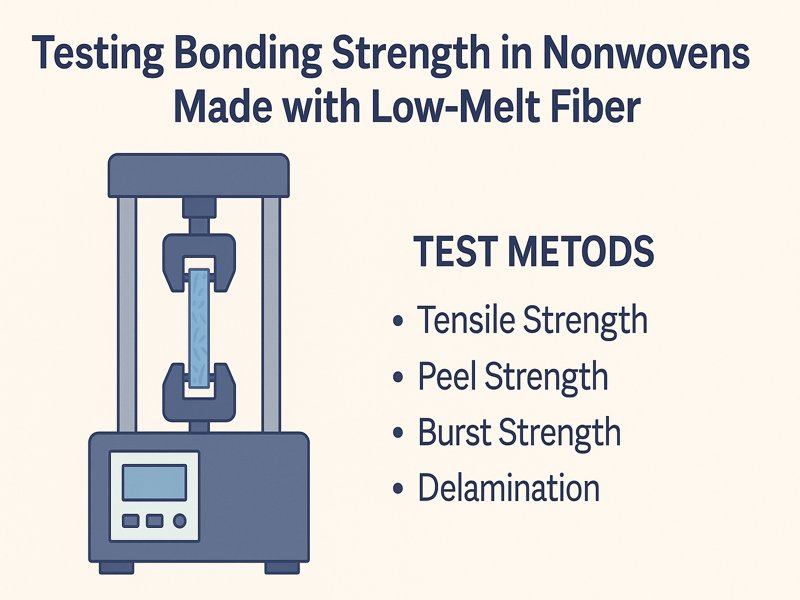Low-melt polyester fibers are key to thermally bonded nonwovens, melting at 110–180°C to act as internal adhesives. Used in filters, insulation, and hygiene products, they ensure strong, uniform fabrics without external binders. Understanding their bonding strength is vital for performance and compliance. This article covers testing methods, influencing factors, and how results support quality control and product development.
Understanding Bonding Strength in Nonwovens
Bonding strength in nonwovens refers to the force required to separate fibers that have been thermally fused by low-melt components. It reflects the integrity and durability of the final product and influences properties such as:
- Tensile strength
- Peel strength
- Burst resistance
- Dimensional stability
- Resistance to delamination or tearing
Achieving optimal bonding is a balancing act. Too little bonding results in weak fabrics, while excessive bonding can lead to stiffness, reduced breathability, or fiber degradation.
Why Testing Bonding Strength Matters
Testing bonding strength is essential in various stages:
- Quality control during production to ensure consistent bonding
- R&D to compare different low-melt fiber formulations or processing parameters
- Material certification for industries with performance standards (e.g., automotive, medical)
- Failure analysis in case of product issues like delamination or reduced lifespan
Reliable testing methods provide measurable, repeatable data that helps manufacturers maintain product integrity and meet customer expectations.

Key Methods to Test Bonding Strength in Nonwovens
Different test methods evaluate bonding performance under various stress conditions. The most commonly used ones include:
Tensile Strength Test
Description:
This test measures the force required to pull the fabric apart in one direction. It gives a good indication of the general strength of the bonded structure.
Procedure:
- Prepare a fabric specimen (e.g., 50mm x 200mm)
- Clap the ends in a universal testing machine (UTM)
- Stretch at a constant speed (commonly 300 mm/min)
- Record the maximum force before the rupture
Standards:
- ASTM D5035 (Strip Method)
- ISO 9073-3
Result:
Tensile strength is usually reported in N/50mm or MPa, and variations can indicate differences in fiber distribution, bonding temperature, or density.
Peel Strength Test
Description:
This test measures the force required to peel two layers of bonded nonwoven fabric apart. It reflects the bonding interface strength created by low-melt fiber fusion.
Procedure:
- Two fabric layers are bonded and then separated at a fixed angle (usually 180° or 90°)
- The peeling process is recorded in a tensile tester
- The force required to maintain separation is measured
Standards:
- ASTM D2724
- ISO 11339
Result:
Peel strength is reported in N/cm or N/inch, indicating the consistency of thermal bonding across the surface.
Burst Strength Test
Description:
Burst strength tests evaluate how much pressure the fabric can endure before it ruptures. It’s particularly relevant for nonwovens used in filtration, packaging, or protective applications.
Procedure:
- A circular fabric sample is clamped in a diaphragm-bursting tester
- Hydraulic or pneumatic pressure is applied centrally
- The pressure at rupture is recorded
Standards:
- ASTM D3786
- ISO 13938-1
Result:
Reported in kPa or psi, burst strength indicates how well the bonded matrix distributes pressure.
Tear Resistance Test
Description:
This measures the force needed to propagate a tear in a bonded nonwoven sample, offering insight into the robustness of local bonding.
Procedure:
- A precut fabric sample is subjected to tensile stress
- The resistance to extending the tear is measured
Standards:
- ASTM D5733 (Trapezoid Method)
- ISO 9073-4
Result:
Reported in N or lbf, tear resistance reflects the nonwoven’s ability to resist cracking or delamination under stress.
Delamination Test
Description:
This test is used when nonwovens are layered or laminated (e.g., filter media or multilayer insulation) and assesses how much force is required to separate bonded layers.
Procedure:
Layers are pulled apart manually or using a UTM
The force and energy needed to delaminate are recorded
Standards:
ASTM F88
ISO 11339 (for peel in laminates)
Result:
Results may be recorded as force per unit width (N/cm) or energy to delaminate, showing bonding performance in layered composites.
Factors That Influence Bonding Strength
Achieving consistent bonding strength requires control over various parameters during both material selection and manufacturing.
Low-Melt Fiber Properties
- Melting Point: A Lower melting point leads to earlier softening and bonding
- Fiber Fineness: Finer fibers create more surface area for bonding
- Sheath-core or side-by-side structure: Influences melting behavior and bond uniformity
Blending Ratio
The proportion of low-melt fibers to regular fibers determines the bonding density. Higher LM content usually enhances bonding strength but may reduce softness.
Temperature and Dwell Time
The bonding temperature must be high enough to melt the low-melt sheath but not so high that it degrades fibers. Dwell time (time under heat/pressure) also affects the depth of fusion.
Pressure during Bonding
In calendar bonding or hot pressing, pressure helps ensure fiber contact and melt flow. Too much pressure can compress the structure excessively or damage fibers.
Web Density and Thickness
Thicker or denser webs may need higher bonding energy to ensure uniform bonding through the depth.
Tips for Effective Testing
Condition Samples Properly
Allow specimens to equilibrate in standard laboratory conditions (typically 21°C and 65% RH) for at least 24 hours before testing to reduce variability.
Ensure Uniform Specimen Preparation
Cut and prepare samples using templates or cutting dies to ensure consistent size and shape. Avoid handling fabric edges excessively, which can introduce weakness.
Use Proper Test Speeds and Grips
Test speeds, grip type (pneumatic or mechanical), and clamping force must conform to standards. Results might be skewed by misalignment, which can cause bending or sliding.
Test in Multiple Directions
Nonwovens may have directional strength differences due to fiber orientation. Always test samples in both machine and cross-machine directions for a full performance picture.
Data Interpretation and Quality Standards
What Good Bond Strength Looks Like
There is no single ideal value for bonding strength—it depends on the application. For example:
- Automotive insulation may require peel strength > 2 N/cm
- Filter media may require tensile strength > 100 N/50mm
- Wadding for bedding may need lower bonding to maintain softness
Quality Control Thresholds
Manufacturers often establish minimum acceptable values for each test based on product specs and customer requirements. Control charts, standard deviations, and rejection criteria help maintain quality.
Innovations in Bond Strength Evaluation
Emerging technologies and methods are being developed to provide more accurate or application-specific insights:
- Acoustic emission analysis: Tracks real-time micro-bond failures under stress
- Infrared imaging: Detects bonding uniformity across the nonwoven surface
- Microscopy: SEM or optical analysis reveals fiber entanglement and melted junctions
These tools offer valuable supplementary data to traditional strength tests.
Testing bonding strength in low-melt fiber nonwovens is vital for quality, validation, and innovation. Methods like tensile, peel, burst, and delamination tests reveal bonding effectiveness. Test selection should match the product’s use, with careful control of fiber type, processing, and preparation. As demand for high-performance, sustainable nonwovens rises, precise strength testing remains key to manufacturing success.

